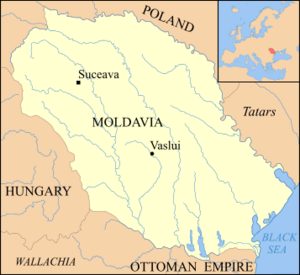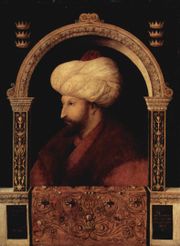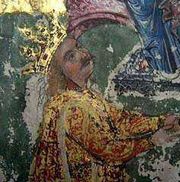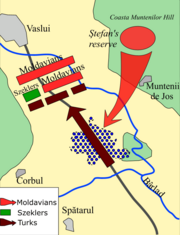Battle of Vaslui
2007 Schools Wikipedia Selection. Related subjects: Pre 1900 Military
| Battle of Vaslui | |||||||
|---|---|---|---|---|---|---|---|
| Part of the Moldavian-Ottoman Wars | |||||||
 |
|||||||
|
|||||||
| Combatants | |||||||
| Moldavia | Ottoman Empire | ||||||
| Commanders | |||||||
| Stephen III of Moldavia | Hadân Suleiman Pasha | ||||||
| Strength | |||||||
| 40,000 Moldavians with 5,000 Szekely recruited by Stephen, 3,800 allied troops 20 cannon |
~ 60,000 - 80,000 17,000 Wallachians (Possibly up to 120,000) |
||||||
| Casualties | |||||||
| Unknown | minimum of 40,000 | ||||||
The Battle of Vaslui (also referred to as the Battle of Podul Înalt and Battle of Racova) ( January 10, 1475) was fought between the Moldavian ( Romanian) Prince, Stephen the Great and the Beylerbeyi of Rumelia, Hadân Suleiman Pasha. The battle took place at Podul Înalt (the High Bridge), near the town of Vaslui, in Moldavia (now part of eastern Romania) between Barnaba and Racovica. The Ottoman troops numbered between 60,000 and 120,000, facing about 40,000 Moldavian troops, plus smaller numbers of allied and mercenary troops on both sides.
Stephen inflicted a decisive defeat on the Ottomans which has been said to be "the greatest ever secured by the Cross against Islam," with casualties, according to Venetian and Polish records, reaching beyond 40,000 on the Ottoman side. As witnessed by Maraym Khanum ( Mara Brankovic), former younger wife of Murad II, to a Venetian envoy, the invasion was the worst defeat for the Ottomans at that time. Stephen was later awarded the title " Athleta Christi" (Champion of Christ) by Pope Sixtus IV. The Polish chronicler, Jan Długosz, hailed Stephen after his victory in the battle:
Praiseworthy hero, in no respect inferior to other hero soldiers we admire. He was the first contemporary among the rulers of the world to score a decisive victory against the Turks. To my mind, he is the worthiest to lead a coalition of the Christian Europe against the Turks.
According to Długosz, Stephen did not celebrate his victory; instead, he fasted for forty days on bread and water and forbade anyone to attribute the victory to him, insisting that credit be given only to " The Lord."
Background
On June 22, 1462, Stephen made an attempt to take the castle of Chilia from the shared Hungarian- Wallachian rulership. The siege failed and Stephen was wounded. In November, the same year, the Ottoman Sultan Mehmed II invaded Wallachia and tried to subdue it. Stephen's cousin, Vlad III Dracula, repelled the invasion, but after the Ottomans retreated, the boyars allied with Dracula's half-brother, Radu the Handsome, who in turn served the Sultan. Dracula fled to Transylvania where he was imprisoned by King Matthias Corvinus of Hungary; the boyars installed Radu as Prince of Wallachia. Three years later, between January 22 and January 26, Stephen successfully besieged Chilia. Since Chilia was then counted as part of Wallachia, the Sultan, having subdued most of Wallachia and made it his vassal, made claims to the town and asked Stephen to handle it back to Wallachia.
The ports of Chilia and Akkerman (Romanian: Cetatea Albā; now known by the Ukrainian name Bilhorod-Dnistrovskyi) were essential for Moldavian commerce, hosting Armenian merchants who made trade a very profitable business. The towns developed into rich market centers. The old trade route from Caffa, Akkerman, and Chilia passed through Suceava in Moldavia and Lwow in Poland (now in Ukraine). Both Poland and Hungary had previously made attempts to control the region, but failed; and for the Ottomans, "the control of these two ports and of Caffa was as much an economic as a political necessity", as it would also give them a better grip on Moldavia and serve as a valuable strategic point from which naval attacks could be launched against the Commonwealth of Poland-Lithuania. Stephen refused to give up Chilia and Akkerman and in 1470, he invaded Wallachia and burned down the town of Brăila. In retaliation, the Turks crossed the Dniester and pillaged a few Moldavian towns. In 1474, after defeating an army consisting of 12,000 Ottomans and 6,000 Wallachians, Stephen captured the castle of Bucharest and took Radu's wife and daughter — whom the latter he married — and replaced Radu with the seemingly loyal Prince, Basarab Laiotā. Mehmed gave Stephen an ultimatum of forfeiting Chilia and Akkerman to the Porte and coming to Constantinople with his delayed homage. Stephen refused and in November 1474, he wrote to the Pope, warning him of further Ottoman expansion and asking for assistance.
Preparations for war
Ottomans
Mehmed ordered his great general, Suleiman Pasha, to end the siege of Venetian-controlled Shkodër (now in Albania), to assemble his troops in Sofia, and from there to advance with additional troops towards Moldavia. For these already exhausted Ottoman troops, the transit from Shkodër to Moldavia was a month's journey through bad weather and difficult terrain. According to Długosz, Suleiman was also ordered that after inflicting defeat on Stephen, he was to advance towards Poland, set camp for the winter, and in spring invade Hungary and unite his forces with the army of the Sultan. The Ottoman army consisted of Janissaries and heavy infantry, which were supported by the heavy cavalry sipahis and by the light cavalry—known as Akinci—who would scout ahead; there were also Tatar cavalry and other troops (such as the Timariots ) from vassal states. Twenty-thousand Bulgarian peasants were also included in the army; their main tasks were to clear the way for the rest of the army by building bridges over waters and removing snow from the roads, and to drive supply wagons. In total, the Ottoman cavalry numbered 30,000. Most documents put the number of Ottoman troops as high as 120,000, while other sources mention anything from 60,000 and 80,000. Of this number, about 40,000 constituted a standing army, while the rest were to be paid in booty. In September 1474, the Ottoman army gathered in Sofia, and from there, Suleiman marched towards Moldavia by crossing the frozen Danube on foot.. Their first stop was Wallachia, in which they entered via Vidin and Nicopolis. The army rested in Wallachia for two weeks, and was later joined by a Wallachian contingent of 17,000 under Basarab Laiotă, who had changed sides in favour of the Ottomans.
Moldavians
Stephen was hoping to gain support from the West, and more specifically from the Pope. The help that he received was modest in numbers. The Hungarian Kingdom sent 1,800 Hungarians and Poland sent 2,000 horsemen. Stephen recruited 5,000 Szekely soldiers. The Moldavian army consisted of twenty cannon; light cavalry (Călăraşi); elite, heavy cavalry – named Viteji, Curteni, and Boyars – and professional foot soldiers. Each piece of artillery was prepared with powder and ammunition to fire at least 7 times. The army reached a strength of up to 40,000, of whom 10,000 to 15,000 comprised the standing army. The rest of the force consisted of 30,000 peasants armed with maces, bows, and other home-made weapons. They were recruited into Oastea Mare (the Great Army), into which all able-bodied free males over the age of 14 were conscripted.
Battle
The invading army entered Moldavia in December 1474. Stephen had instituted a policy of scorched earth and poisoned waters in order to fatigue the Ottomans. Troops who specialised in setting ambushes harassed the advancing Ottomans. The population, and animals, were evacuated to the north of the country, in the mountains. Ottoman scouts reported to Suleiman that there were untouched villages near Vaslui, and the Ottomans headed for that region. The winter made it difficult to set camp, which forced the Ottomans to move quickly and head for the Moldavian capital, Suceava. In order to reach Vaslui, where the Moldavian army had its main camp, they needed to cross Podul Înalt (The High Bridge) over the Bârlad River. The bridge was made of wood and not suitable for heavy transportation of troops. Stephen chose that area for the battle—the same location where his father, Bogdan II, defeated the Poles in 1450, when Stephen was 17. The area was ideal for the defenders: the valley was a semi-oval surrounded by hills covered by forest on all three sides. Inside the valley the terrain was marshy, which restricted troop movement. Suleiman had full confidence in his troops and made few efforts to scout the area.
On January 10, on a dark and misty Tuesday morning, the battle began. The weather was frigid, and a dense fog limited vision. The Ottoman troops were exhausted and the torrent made them look like "plucked chickens". Stephen fortifed the bridge while setting aiming his cannons at the structure. Peasants and archers were hidden in the forest, together with their Prince and his boyar cavalry. The Moldavians made the first move by sending musicians to the middle of the valley. The sound of drums and bugles made Suleiman think that the entire Moldavian army awaited him there. Instead, the centre of the valley held the Szekely forces and the Moldavian professional army, which were ordered to make a slow retreat when they encountered the enemy. Suleiman ordered his troops to advance and, when they made enough progress, the Moldavian artillery started to fire, followed by archers and handgunners firing from three different directions. The archers could not see the enemy for the fog, and, instead, had to follow the noise of their footsteps. The Moldavian light cavalry then helped to lure the Ottoman troops into the valley by making hit-and-run attacks. Ottoman cavalry tried to cross the wooden bridge, causing it to collapse. Those Ottoman soldiers who managed to survive the attacks from the artillery and the archers, and who did not get caught in the marshes, had to confront the Moldavian army, together with the Szekely soldiers further up the valley. The 5,000 Szekely soldiers were successful in repelling the 7,000 Ottoman infantrymen. Thereafter, they made a slow retreat, as instructed by Stephen, but were later routed by the Ottoman sipahi,, while the remaining Ottoman infantry attacked the Moldavian flanks.
Suleiman tried to reinforce his offensive, not knowing what transpired in the valley, but then Stephen ordered a major attack. All his troops, together with peasants and heavy cavalry, attacked from all sides. Simultaneously, Moldavian buglers concealed behind Ottoman lines started to sound their bugles, and in great confusion some Ottoman units changed direction to face the sound. When the Moldavian army hit, Suleiman lost control of his army and signalled a retreat. The fleeing Ottoman army was pursued by the Moldavian light cavalry and the 2,000-strong Polish cavalry for three days until they reached the town of Obluciţa (now Isaccea, Romania), in Dobruja.
The Wallachians fled the field without joining battle and Laiotă now turned his sword against the Turks, who had hoped for a safe passage in Wallachia; he took one of their flags and sent it to a Hungarian friend as proof of his bravery. The Ottoman casualties were counted as 45,000, including four Pashas killed and a hundred standards taken. Jan Długosz writes that "all but the most eminent of the Turkish prisoners are impaled", and their corpses burned. Only one was spared — the only son of the Ottoman general Isaac Bey, of the Gazi Evrenos family. Another Polish chronicler reported that on the spot of the battle rested huge piles of bones upon each other, next to three immuned crosses.
Aftermath
After the battle, Stephen sent "four of the captured Turkish commanders, together with thirty-six of their standards and much splendid booty, to King Casimir in Lithuania" and implored him to support him in the struggle against the Ottomans with troops and money. He also sent letters and a few prisoners and Turkish standards to the Pope and King Matthias Corvinus, asking for support. In response, "the arrogant Matthias writes to the Pope, the Emperor and other kings and princes, telling them that he has defeated a large Turkish army with his own forces under the Voivode of Wallachia." The Pope's reply to Stephen denied him help, but awarded him with the " Athleta Christi", while King Casimir pleaded "poverty both in money and men" and did nothing; his own men then accused him of sloth and advised him to change his shameful behaviour or hand over his rule to someone else.
The following year, Mehmed himself invaded the country with an army of 150,000, which was joined by 10,000 Wallachians under Laiotă and 30,000 Tatars under Meñli I Giray. The Tatars, who called for a Holy War, attacked with their cavalry from the north and started to pillage the country. The Moldavians took chase after them, routed and killed most of them. "The fleeing Tatars discard their weapons, their saddles and clothes, while some, as though crazed, jump into the River Dniepr." Giray wrote to Mehmed that he could not wage more war against Stephen, as he lost his son, two brothers, and returned with only one horse. In July 1476, after killing 30,000 Ottomans, Stephen was defeated at the Battle of Valea Albă. The Ottomans were unsuccessful in their siege of the Suceava citadel and the Neamţ fortress, while Laiotă was forced to retreat back to Wallachia when Vlad Dracula and Stefan Báthory, Voivode of Transylvania, gave chase with an army of 30,000. The Ottoman troops, who suffered from plague and fatigue, were also forced to retreat.
Stephen assembled his army and invaded Wallachia from the north, while Dracula and Báthory invaded from the west. Laiotă fled and in November, Dracula was installed on the Wallachian throne. He received 200 loyal knights from Stephen that were to serve as his loyal bodyguards, but his army remained small. When Laiotă returned in December, Dracula went to battle and was killed. Laiotă again occupied the Wallachian throne, which urged Stephen to make another return to Wallachia and dethrone Laiotă for the fifth and last time, while Dracula's son Ţepeluş, was put to rule the country. In 1484, the Ottomans under Bayezid II, managed to conquer Bessarabia and incorporate it into their empire under the name of Budjak, leaving Moldavia a landlocked vassal of the Porte (that is, the Ottomans) until it was conquered in the late 16th century by Mihai Viteazul. In 1490, Stephen built the church of Saint John the Baptist, in remembrance of his great victory at Vaslui; the Moldavian churches built by Stephen are on UNESCO's World Heritage List.


